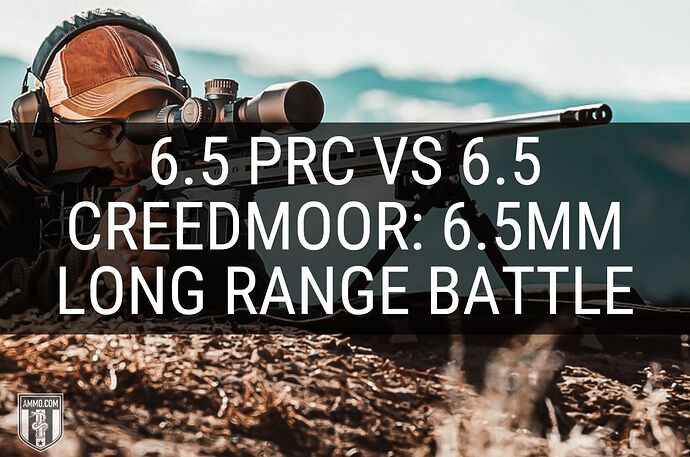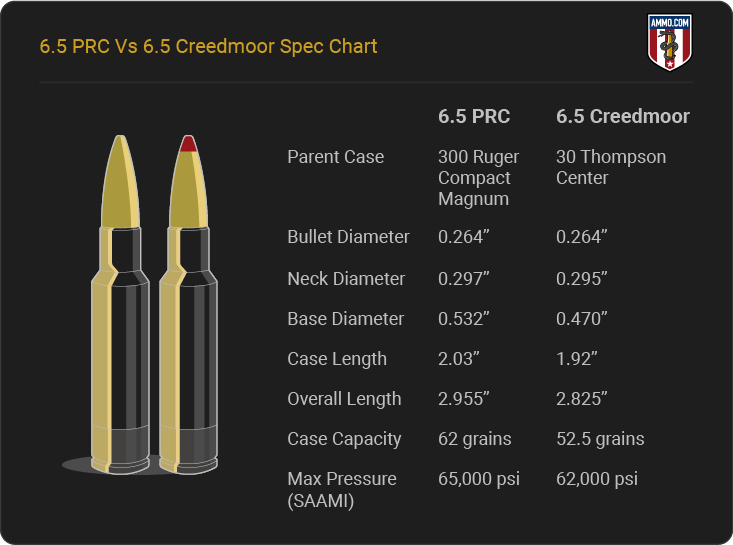In this 6.5 PRC vs. 6.5 Creedmoor comparison, we pit the two rounds head-to-head in several categories. You’ll understand their pros and cons and know which is better suited to your needs.
Keep reading to discover which cartridge dominates distances better. The results … might just surprise you.
6.5 PRC vs. 6.5 Creedmoor Comparison Table
| Category | Winner | Note |
|---|---|---|
| Recoil | 6.5 Creedmoor | The 6.5 Creedmoor has approximately 17 ft-lbs of free recoil vs. 21.6 ft-lbs for the 6.5 PRC. |
| Trajectory | 6.5 PRC | Out to 500 yards, these rounds are virtually identical. Beyond that, the 6.5 PRC has a flatter trajectory. |
| Accuracy | 6.5 PRC | The 6.5 PRC wins a slim margin when firing over distances greater than 500 yards. |
| Ballistic Coefficient | 6.5 PRC | The 6.5 PRC generally has a higher ballistic coefficient than the 6.5 Creedmoor. |
| Stopping Power | 6.5 PRC | The 6.5 PRC wins by a slim margin thanks to its higher velocities (and higher resultant striking energy). |
| Hunting Capabilities | 6.5 PRC | The 6.5 PRC’s longer effective range makes it more versatile. |
| Home Defense | 6.5 Creedmoor | Neither is ideal for defense, but the 6.5 Creedmoor lower recoil and theoretically lower risk of over-penetration give it an edge. |
| Cost/Availability | 6.5 Creedmoor | The 6.5 Creedmoor is much more abundant and available for lower prices. |
| Reloadability | 6.5 Creedmoor | 6.5 Creedmoor components (brass, especially) are easier to source and less expensive. |
6.5 PRC vs. 6.5 Creedmoor Differences & Similarities
We’re comparing these rounds in nine separate categories. That way, we’ll avoid having a draw (unless there’s a draw in an odd number of categories, but what are the odds of that happening?).
In our pursuit of a fair comparison of these rounds, we contacted long-range shooting experts, leaned on our knowledge, researched ballistic data, and went to the shooting range.
Before we start the battle, let’s discuss a few similarities and differences between the cartridges.
Cartridge Specs
It wouldn’t be difficult to mix these two rounds up at the range. The 6.5 Creedmoor could fit into a 6.5 PRC rifle, though they’re far from interchangeable. Far from it, as chambering the more powerful 6.5 PRC into a 6.5 CM firearm could wind up destroying said firearm (to say nothing of whomever fired it).
The biggest difference between the two cartridges is that the 6.5 PRC has a larger case, which holds more propellant, increases chamber pressure, and shortens barrel lifespan. The 6.5 PRC is similar to the 6.8 Western, which, uncoincidentally, is another powerful long-range round.
If you’re looking for even higher case capacity, check out the 26 Nosler. Its case is over 50% more capacious than the 6.5 PRC’s.
Since both of these rounds were developed for the same reasons, it’s no surprise their specs are similar (not unlike 260 Rem vs. 6.5 Creedmoor).
6.5 Creedmoor vs. 6.5 PRC Recoil
Lots of recoil and long-distance shooting go hand-in-hand, right? Well, that might have been the case pre-6.5 Creedmoor, but it’s quickly changing.
Most shooters (myself included) prefer less recoil. It allows us to be more accurate and avoid flinching in anticipation of recoil. Firing is much more comfortable when the first shot doesn’t put a big bruise on your shoulder, too.
So, which round has less recoil?
The 6.5 PRC impacts the shoulder with 21.6 ft-lbs of recoil. The 6.5 Creedmoor hits significantly softer, with only 17 ft-lbs of free recoil.
The first time I fired a 6.5 Creedmoor, I was blown away by its light recoil. Granted, 17 ft-lbs is not inconsequential, but other popular hunting rounds put you through way, way worse recoil.
You probably wouldn’t notice much difference while firing these rounds side by side. Even so, the 6.5 Creedmoor takes an early lead.
Trajectory
The bullet’s trajectory plays a significant role in long-distance accuracy. I’ve never met someone who prefers firing a bullet with a steeply arching trajectory over a flatter one.
A flat trajectory allows you to compensate less for bullet drop. More accuracy. Less math. Very nice.
Out to 500 yards, these rounds’ performance is virtually identical, with the 6.5 PRC having a slightly flatter trajectory.
When zeroed at 200 yards, the 6.5 PRC drops 6.1" at 300 yards; 34.6" at 500 yards.
When zeroed at 200 yards, the 6.5 Creedmoor drops 9.6" at 300 yards; 48.9" at 500 yards.
It’s when we pass 500 yards that the 6.5 PRC begins to drastically outperform the 6.5 Creedmoor.
If we’re looking to name the “Dominator of the Distances,” the 6.5 PRC takes it with its flatter trajectory at extended ranges.
Continue reading 6.5 PRC vs. 6.5 Creedmoor: 6.5mm Long-Range Battle on Ammo.com

